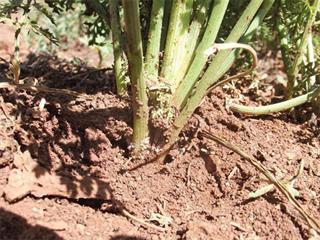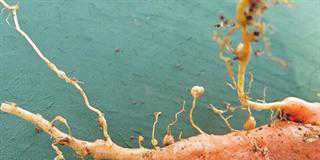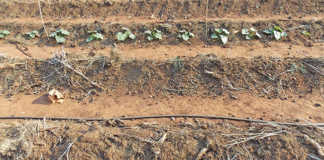
One is cutworm, which is not normally noticed until the damage becomes visible. It is the larva of a grey night-flying moth, which lays single eggs randomly on young weeds and plants. The caterpillars can hatch and stay alive long before the carrots are planted. Even when the land is considered ‘clean’, they can survive on dry plant debris for most of their life.
Prior to land preparation, check the weeds on the plot for cutworm damage. Even if you don’t see any, it’s best to assume that cutworms are present and spray before germination. This is not the end of the matter, though. When germinating weeds that survived the pre-emergence herbicide appear, the moths may lay their eggs on these as well as on the newly-emerged carrots. It is easy to be caught out; because you’re expecting no more problems, you may drive past the land without stopping for a close inspection.
Meanwhile, the newly-hatched cutworms start eating the tender young leaves of the weeds. When these are burnt off by the post-emergence herbicide, the caterpillars turn to the young carrot seedlings and start to munch away at ground level. By the time you notice that the stand is thinned out, substantial damage may have been done. For this reason, it is a good idea to apply a pyrethroid with the post-emergence application.
Semi-looper caterpillars
Watch out too for semi-loopers. These caterpillars appear sporadically as they are usually well- controlled by a highly effective parasitoid. But if parasitic wasp numbers decline, semi-loopers can increase extremely rapidly and attack many different crops. I once saw an entire district infested with these caterpillars. The first sign of a problem was when egrets and other birds started flocking to the carrot lands to eat the semi-loopers.
A pest more likely to occur on smallholdings than on large commercial farms is the carrot aphid. Unlike others of the family, carrot aphids operate near or below ground level. Because of this, and their pale colour, they are usually overlooked. In addition, they are almost always associated with ants, which heap up soil around the plants to keep the aphids hidden and safe.
The ants do this because they ‘harvest’ honeydew – a clear, sugary liquid that these insects condense from plant sap and secrete – directly from the aphids. In return, the aphids gain protection from predators. This why aphids tend to be a problem in small lands; there is much more uncultivated land nearby, where ants are likely to occur. Watch out for plants with red leaves; this is caused by a virus carried by the aphids. Plants can become stunted when infected at an early age. If the aphids are left unchecked, winged adults may spread the virus to other parts of the land.
Physiological disorders
Eelworm is not the only cause of root problems. Although forked roots are normally associated with these pests, anything that interferes with tap root growth causes the roots to fork. It can occur, for example, if too much nitrogen is applied as ammonia shortly before or just after planting.
Roots can also fork or become hairy if there is too much organic matter in the soil. This is especially likely when the organic matter is still in the process of decomposing. For this reason, you should not apply manure before planting. Rather plant another crop before going over to carrots.
A sudden rise in the water table can also cause the roots to fork. This can occur with heavy rain and poor drainage. The tap root dies due to lack of oxygen, causing side roots to develop.













